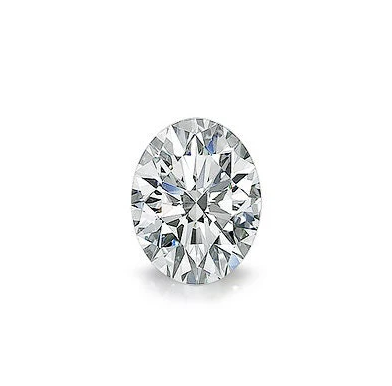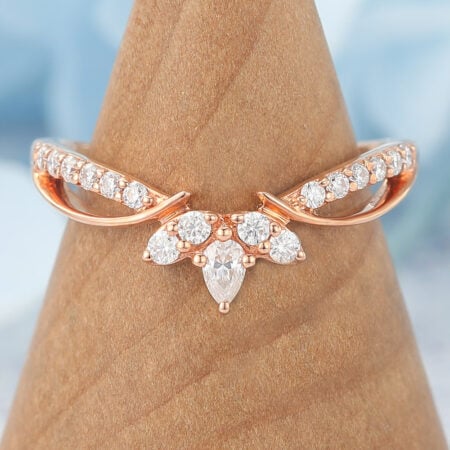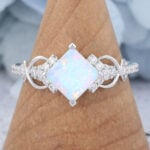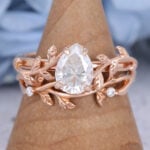Simulated Diamond vs Moissanite: Key Differences You Need to Know Before Buying
When shopping for a diamond alternative, understanding the differences between options is essential. This guide provides a simulated diamond vs moissanite side by side comparison, helping you see how each stone performs in terms of appearance, durability, and value. By exploring their unique qualities, you can make a confident choice that suits your style and budget.
What Are Simulated Diamonds?
Simulated diamonds, also known as diamond simulants or imitation diamonds, are gemstones that closely resemble real diamonds in appearance but differ in chemical composition and physical structure. This forms the basis of the simulated diamond definition—they are not genuine diamonds, but rather alternatives created to mimic their look. Common types of imitation diamonds include cubic zirconia, white sapphire, and glass. Because simulated diamonds lack the rarity of natural diamonds, their prices are significantly more affordable, making them a popular and budget-friendly choice among natural diamond alternatives.
Read More About: What Is a Simulated Diamond? Meaning, Differences, and How to Tell It Apart

cubic zirconia
What Is Moissanite?
Moissanite is a naturally occurring but extremely rare mineral composed of silicon carbide (SiC). It was first discovered in 1893 by French chemist Henri Moissan in a meteor crater in Arizona, which is how it got its name. Due to the scarcity of natural moissanite stones, most moissanite available on the market today is lab-grown genuine moissanite. As a high-quality gemstone, moissanite has become one of the most popular diamond alternative options in the modern jewelry market.

Simulated Diamond vs Moissanite: Side-by-Side Comparison
Appearance
While both simulated diamond and moissanite can be considered diamond alternatives and possess a similar appearance, there are subtle differences. Simulated diamonds typically have a more monochromatic fire, lacking the refractive index and brilliance of natural diamonds. They are generally transparent and colorless, though dyed versions are also available.
Moissanite, often considered the “best fake diamond,” has a refractive index and fire closer to diamond, resulting in a more intense and natural sparkle. While its color may be slightly yellowish or gray, high-quality colorless moissanite is virtually indistinguishable from diamond. Its fire is richer and its brilliance is brighter than simulated diamonds.
Chemical Composition
Common man-made simulated diamonds include cubic zirconia, white sapphire, and glass, all of which have chemical compositions entirely different from natural diamonds. Cubic zirconia is zirconium oxide (ZrO₂), white sapphire is aluminum oxide (Al₂O₃), and glass is primarily composed of silicon dioxide and other minerals. These materials, when cut and polished, can mimic the appearance of diamonds, but their carbon structure is fundamentally unlike that of real diamonds.
Moissanite, composed of silicon carbide (SiC), contains carbon like diamond but has a distinct crystal structure. Its silicon carbide lattice provides a high refractive index, intense fire, and hardness second only to diamond. While not a diamond, moissanite’s chemical composition and physical properties make it closer to natural diamonds than most simulants.
Hardness & Durability
For example, cubic zirconia, the most common type of imitation diamond, has a Mohs hardness of 5–8. They are easily scratched or chipped, making them unsuitable for jewelry worn frequently on a daily basis.
Moissanite has a Mohs hardness of approximately 9.25, second only to natural diamond (10), and is far more durable than most imitation diamond materials (except white sapphire). It is not easily scratched or damaged, making it ideal for everyday wear as a ring, necklace, or earring, maintaining its luster and fire for a long time.
Price
Simulated diamonds are very affordable and come in materials like cubic zirconia (CZ), white sapphire, and glass. Small or medium-sized simulated diamonds typically cost only a few to tens of dollars, and even large or finely cut models are significantly cheaper than natural diamonds of the same size. This low cost makes simulated diamonds a popular choice for jewelry lovers on a budget or those looking to experiment with the look of diamonds.
Moissanite is significantly more expensive than common simulated diamonds, but still significantly more affordable than natural diamonds. High-quality colorless moissanite can typically be purchased for one-quarter to one-third the price of a natural diamond. While the initial investment is higher than simulated diamonds, moissanite’s durability, brilliance, and fire are closer to diamonds, making it an extremely cost-effective choice for wedding rings or fine jewelry.
Refractive Index
When it comes to refractive index, simulated diamonds (such as cubic zirconia, white sapphire, and glass) differ significantly from diamonds and moissanite. Diamonds have a refractive index of approximately 2.42, while most simulated diamonds have a much lower index—for example, cubic zirconia has a refractive index of approximately 2.15, and white sapphire has a refractive index of only approximately 1.76. This means they cannot match the brilliance and sparkle of diamonds.
Moissanite has a refractive index of approximately 2.65, even higher than diamond, resulting in a more intense and vibrant fire when exposed to light. This high refractive index often gives moissanite a more “sparkly” appearance than diamond, contributing to its widespread popularity in the jewelry market.
Resale Value and Long-Term Wear
When it comes to resale value, there’s a significant difference between simulated diamonds and moissanite. Simulated diamonds, including cubic zirconia and white sapphire, have little resale value due to the low price of the materials themselves and limited market demand. They primarily serve as practical and economical decorative items. Even highly crafted, man-made simulated diamonds are difficult to recycle or maintain their value in the secondary market.
While moissanite isn’t a natural diamond, its high hardness (9.25 Mohs), intense brilliance, and excellent abrasion resistance allow it to withstand long-term wear and maintain its appearance. While its secondary market value isn’t as high as that of natural diamonds, it has greater recycling potential than simulated diamonds. High-quality moissanite, in particular, still has some resale value among specific buyer groups.
Maintenance
Simulated diamonds (such as cubic zirconia and white sapphire) have a relatively low hardness and are more susceptible to scratches and surface wear with daily wear. Prolonged wear can also cause the surface to lose its luster due to oil, dust, or makeup residue, requiring more frequent cleaning and maintenance.
Moissanite, with a hardness of 9.25 (second only to diamond), is more abrasion- and scratch-resistant, making daily care relatively simple. It is less susceptible to visible scratches from wear, and its high refractive index maintains its sparkle even with minor stains. However, to maintain optimal luster, regular cleaning with warm water and a neutral detergent, and using an ultrasonic cleaner to remove stubborn stains, is recommended.
Pros and Cons of Simulated Diamonds
Pros of Simulated Diamonds
- Affordable Price: Significantly cheaper than natural diamonds, making them budget-friendly.
- Variety of Options: Available in different types of imitation diamonds like cubic zirconia, white sapphire, and glass.
- Ethical and Conflict-Free: Conflict-free simulated diamonds are produced responsibly, avoiding funding conflicts or unethical practices.
- Customizable Looks: Can be cut, shaped, and colored to suit various jewelry designs.
Cons of Simulated Diamonds
- Lower Durability: Softer and more prone to scratches or damage than natural diamonds.
- Less Brilliance: Generally have a lower refractive index, so they sparkle less.
- Shorter Lifespan: May lose clarity and shine faster with daily wear.
- Lower Resale Value: Not considered rare or collectible, so resale prices are low.
Pros and Cons of Moissanite
Pros of Moissanite
- Brilliant Sparkle: High refractive index gives intense fire and brilliance, often more dazzling than diamonds.
- Durable: Hardness of 9.25 on Mohs scale makes it resistant to scratches and suitable for everyday wear.
- Ethical and Lab-Grown: Produced in a controlled environment without ethical concerns linked to mining.
- Affordable Alternative: More budget-friendly than natural diamonds while offering similar visual appeal.
Cons of Moissanite
- Color Variations: Some stones may have a slight yellow or gray tint compared to colorless diamonds.
- Lower Resale Value: Although valuable, moissanite does not hold resale value like natural diamonds.
- Not a Natural Diamond: While chemically similar, it is not a true diamond, which may matter to some buyers.
Which One Should You Choose?
Choosing between simulated diamonds and moissanite depends on your priorities. If budget is your main concern, simulated diamonds are ideal due to their low cost and wide variety of styles. For those seeking ethical, conflict-free jewelry that mimics a diamond’s appearance without compromise, conflict-free simulated diamonds are a strong choice.
If durability, long-term wear, and brilliance are more important, moissanite is recommended. Its high hardness, exceptional sparkle, and lasting quality make it suitable for engagement rings and everyday pieces. For buyers who value investment potential or a closer diamond-like performance, moissanite often offers better long-term satisfaction than typical simulated diamonds.
Real Diamond vs Simulated Diamond vs Synthetic Diamond vs Moissanite, What’s the Differences?
Real diamonds are naturally formed over millions of years, composed purely of carbon in a crystalline structure. Their rarity, durability, and investment value make them the most coveted, and no man-made process can replicate their natural origin.
Synthetic diamonds, also known as lab-grown diamonds or lab created diamonds, share the same chemical and physical properties as natural diamonds. They are real diamonds produced in a laboratory, offering an ethical and often more affordable alternative to mined stones. Compared to lab grown diamond simulants, synthetic diamonds are identical to natural diamonds in hardness, brilliance, and long-term durability.
Simulated diamonds, such as cubic zirconia or white sapphire, are designed to look like diamonds but differ chemically and physically. As a best imitation diamond, they provide a visually similar sparkle at a fraction of the cost. They are ideal for fashion jewelry or budget-conscious buyers but lack the hardness and resale value of natural or lab-grown diamonds.
Moissanite, a popular diamond alternative moissanite, is composed of silicon carbide. Known for its high refractive index and intense fire, it often rivals diamonds in brilliance. A moissanite stone offers durability for everyday wear and is an ethical choice. In a moissanite diamond comparison, moissanite outperforms most simulated diamonds in hardness, sparkle, and longevity, making it a strong option for engagement rings or fine jewelry.

Conclusion
The Simulated Diamond vs Moissanite comparison highlights key factors like cost, durability, and sparkle. The main difference between simulated diamond and moissanite is in composition and brilliance. Simulated diamonds are budget-friendly, while moissanite offers greater durability and fire, making it ideal for long-term wear.
FAQs About Simulated Diamond vs Moissanite
What is a simulated diamond?
A simulated diamond is a gemstone that looks like a real diamond but has a different chemical composition and physical structure.
What is the best imitation diamond?
The best imitation diamond refers to high-quality simulated diamonds like cubic zirconia that closely mimic a diamond’s appearance.
Is a simulated diamond a real diamond? Are VVS simulated diamonds real?
No, simulated diamonds, including VVS grades, are not real diamonds; they only resemble natural diamonds visually.
Is a moissanite a real diamond? Or is moissanite a fake diamond?
Moissanite is not a real diamond; it is a separate gemstone known as a diamond alternative moissanite.
How is moissanite created?
Moissanite is usually lab-created from silicon carbide to produce a durable and sparkly gemstone.
What's the difference between moissanite and diamond?
The difference lies in chemical composition, hardness, brilliance, and price—moissanite is harder than many simulants but slightly less hard than diamond.
Which is more sparkly, diamond or moissanite?
Moissanite generally exhibits more fire and sparkle than a diamond due to its higher refractive index.
Is moissanite stronger and better than diamond?
Moissanite is very durable but not as hard as diamond; “better” depends on whether you prioritize brilliance or long-term hardness.
What is a conflict-free simulated diamond?
A conflict-free simulated diamond is a man-made diamond alternative produced ethically without contributing to conflict or exploitation.
What is a SONA simulated diamond?
A SONA simulated diamond is a type of high-quality cubic zirconia designed to mimic a real diamond’s look.
What does a simulated diamond mean?
A simulated diamond is a gemstone designed to resemble a natural diamond, and simulated diamond meaning refers to this visual imitation without being a real diamond.
1 carat simulated diamond ring vs 1 carat moissanite ring, which one looks bigger visually?
A 1-carat moissanite ring usually appears slightly larger than a 1-carat simulated diamond due to its greater brilliance and sparkle.



